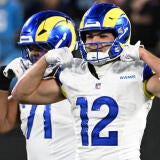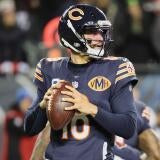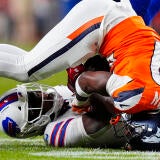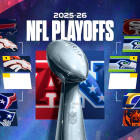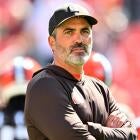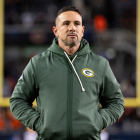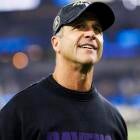
Bills 2024 preview: Can Josh Allen and a cast of new characters finally break through?
The bill came due for the Bills this offseason, meaning lots of big-name departures

This is Part 5 of NFL Thursday Thoughts, a big-picture series of key topics heading into the season. The Bills -- ever heartbroken, ever hopeful -- are today's focus.
Thirty-four seasons' worth of service, nine Pro-Bowl selections, seven All-Pro honors, 8,102 yards receiving, 1,416 tackles, 56 interceptions and six key members of a championship-caliber, what-could-have-been core.
That's what the Bills lost this offseason when they traded Stefon Diggs to the Texans, lost Gabe Davis in free agency and released Jordan Poyer, Micah Hyde, Tre'Davious White and Mitch Morse. In the four releases, the Bills made difficult but necessary decisions; Buffalo was about $40 million over the cap.
In Diggs, the Bills made a perhaps not-so-difficult decision: Diggs, too, was owed huge money in the future, he had shown frustration on several occasions, and he had a quiet second half, coinciding with Buffalo's late-season surge. As such, that split may have been easier to swallow.
The numbers above are huge. Their absences will be felt; to what degree remains to be determined. The following numbers are small: three and six. That's the Bills' losing margins against the Chiefs in the teams' past two playoff meetings. Last season, Buffalo led entering the fourth quarter before giving up a quick touchdown, failing on a fake punt deep in its own territory and missing a field goal with under two minutes left. In 2021, Buffalo was 13 agonizing seconds away from advancing to the conference championship before Patrick Mahomes led a game-tying drive as time expired and a game-winning drive after receiving the overtime kickoff.
So close yet so far for a loaded roster.
It's almost too much to bear, especially when you couple the heartbreak of four straight Super Bowl losses in the 1990s. But the reason it's almost too much -- and not actually too much -- is that Josh Allen is still a Buffalo Bill.
We've seen Mahomes be the rising tide that lifts all ships. Now, the questions are whether Allen can be the dominant tide, and whether there are enough ships around him to bring a Lombardi Trophy back to upstate New York.
Let's assess three categories: Allen, the offense and the defense.
Allen's 2023 was really, really good
Given the big names that left, maybe this seems like a rebuilding year. That would be wrong. Perhaps GM Brandon Beane put it best.
"We got Josh Allen, and we want to compete every single year for a championship," he told The Athletic Football Show in May.
For all of the frustrations Allen causes with his turnovers, he is an absolute superstar, and he more than makes up for those mistakes with his big-play ability, improvising and the most underrated part of his game, down-to-down consistency. Last season, Allen ranked second in success rate, in which a successful first- or second-down play is gaining at least half the yards needed for a first down and a successful third- or fourth-down play is converting for a first down. Only Brock Purdy was better.
Since 2020, Allen leads the league in this category, just ahead of Mahomes and Purdy. He does a remarkable job keeping Buffalo's offense on schedule, and he continues to improve in that aspect. Last year, Allen was sacked on just 10.3% of the dropbacks in which he was pressured. That was not only a career best but also the best in the NFL, slightly ahead of Mahomes, who is regarded as the league's premier pressure navigator. Allen also improved on his accuracy with career bests in completion percentage and off-target rate.
That consistency came the jaw-dropping, put-your-team-on-your-back moments, too. Only Tua Tagovailoa and Dak Prescott had more plays that went for at least 10 yards. Only Jalen Hurts converted more on third or fourth downs. And Allen's penchant for the end zone remains supreme. He led the NFL in total touchdowns (passing + rushing + receiving) and became the first player in NFL history to have multiple total touchdowns in 16 games in a single season. He's a scoring machine.
He's also a turnover machine. Since 2020, Allen leads the league in both turnovers (75) and total touchdowns (174), the first player to hold that distinction over a four-season span since Brett Favre from 1996-99.
It's crucial to provide context to Allen's turnovers, though, because not all turnovers are the same. For this, we can turn to expected points added. When a quarterback throws an interception on first and goal, for example, it's especially damaging because it takes away an opportunity for his team to score -- hence, major expected points lost. When a quarterback throws an interception on third and 10 from midfield, it's less damaging, because his team was less likely to score points prior to that play -- hence fewer expected points lost.
Using expected points added (or, in this case, subtracted) per play, only Justin Herbert's turnovers were less "harmful" to his team. Allen threw interceptions on deep passes near midfield on third and 15, third and 20 and third and 8 -- what we can effectively coin "arm punts" -- threw another interception on a Hail Mary right before halftime and lost a fumble as time expired with the Bills needing a lateral-filled miracle. These plays were, basically, negligible. So, no, Allen's 22 turnovers last year is not pretty. But when you realize that nearly a quarter of them were essentially meaningless, it paints a prettier picture.
This isn't to absolve Allen of responsibility. There are plenty of devastating, maddening miscues. Allen plays every down like it's his last, like he's a superhero -- and, at times, he is -- and that leads to high highs and low lows. But it's also worth pointing out that when it matters most, turnovers haven't been an issue. Since the 2020 season, he has five turnovers in nine career playoff games and the same playoff turnover rate as Mahomes (1.2%).
In an alternate reality in which Mahomes doesn't exist -- one Bills fans would love to visit -- we're potentially talking about multi-time Super Bowl champion, multi-time MVP Josh Allen. But Mahomes exists, and he's brought more heartbreak to Allen's Bills than anyone else. If there's any player who can truly go toe-to-toe with Mahomes on the biggest stage, it's Allen. He just needs the playoff wins.
What to make of the offense (and offensive staff) around Allen
There's an idea that Allen made a huge leap when the Bills fired offensive coordinator Ken Dorsey and elevated Joe Brady to play caller in mid-November. It certainly helped that Buffalo had a 5-5 record before the firing and a 6-1 record afterward.
But that idea wasn't really real. In fact, Allen had a worse touchdown-to-interception ratio, passer rating and sack rate under Brady. At best, he was roughly similar to his pre-Brady form overall.
The Bills promoted Brady to full-time offensive coordinator this offseason, and that means it's worth diving into how the offense looked under him. The biggest difference is the rushing game. From Weeks 1-10, Buffalo ran the ball on 41% of its plays, slightly below league average. From Week 11 on, after Brady took over, that skyrocketed to 52%, only behind the Steelers. Allen's major uptick in rushing played a part, but even taking that away, the Bills were more ground-and-pound.
Bills Last Season | Weeks 1-10 under Dorsey | Weeks 11-18 under Brady |
Rush rate | 41.2% (20th in NFL) | 51.8% (2nd in NFL) |
Allen rushes per game | 4.8 | 9.2 |
Allen designed rushes per game | 0.2 | 3.0 |
RB rushes per game | 19.5 | 26.6 |
Unsurprisingly, the personnel changed under Brady. He went with way more plays using six offensive linemen -- over 11 per game, by far the most in the NFL -- and used more two-running back looks. Buffalo also ran the ball far on the edges more and up the middle less. Only the Dolphins ran more on the edges from Week 11 on.
James Cook was the biggest beneficiary. The quick, talented back posted 4.9 yards per carry going left and 5.2 yards per carry going right, both top-dozen rates among the 53 players who had at least 100 carries. While Cook's yards per carry were actually down after Brady took over, he was much more involved overall, highlighted by a 27-touch, 221-yard, two-touchdown performance against the Cowboys in Week 15. Of his 179 rushing yards that afternoon, 140 came on rushes right or left.
As for the receiving work, Diggs and Davis combined for 241 targets last year. That won't be made up by one or even two players.
Cook and Dalton Kincaid will both see their roles increase in the passing game. Kincaid is a big talent who had seven games of 50+ yards receiving as a rookie. Kincaid's snap share was actually down, though, when both he and Dawson Knox were healthy under Brady. Brady used two tight ends far less often than Dorsey did, and part of that is because of the extra linemen. It's hard to squeeze in six linemen, a quarterback, a running back and two tight ends into one play.
Given the losses of Diggs and Davis, though, we'll likely see Brady playing Kincaid as much as possible, perhaps in the slot and out wide as well. Kincaid may really only be a tight end in name, not in actual play position.
As for the "wide" receivers, it's an uncertain bunch. Curtis Samuel is a chess piece who Brady coached to his best season when the two were in Carolina in 2020. Expect to see Samuel all over formations. Khalil Shakir also came on strong late last year, and he's fills the slot.
Then we get to Keon Coleman, the big-bodied former basketball player who garnered mixed reviews. There's concern about the speed, separation and route running, but there's undeniable athletic ability, coordination, toughness and 50/50 ball-winning. It's hard to prognosticate exactly how well or quickly rookies will translate, but Coleman will have a role, and it may grow quickly.
Morse, meanwhile, is the only departure from the offensive line, and while it's a big one, the Bills will slide Connor McGovern from guard to center and have four other holdovers around him, with David Edwards stepping in at left guard. Pro Football Focus graded 2023 second-rounder O'Cyrus Torrence as the team's worst lineman, but there's reason to believe he'll improve in Year 2; McGovern has already seen a difference.
Meet the new (and old) defense
Buffalo's defense was ravaged by injuries last year. White, now with the Rams, played in four games. Matt Milano played in five, Kaiir Elam two, and DaQuan Jones seven. According to FTN's Adjusted Games Lost, the Bills had the 11th-most injured defense in the league.
Even if the health bounces back, the talent is a question. Replacing two safeties is not easy, and that's not to mention Leonard Floyd, who led the team with 10.5 sacks, is now in San Francisco. Buffalo is relying on a lot of improvements and/or bounce backs at key spots. Up front, Jones and Ed Oliver form a fearsome defensive tackle duo, but is there enough juice off the edge from Gregory Rousseau, AJ Epenesa and Von Miller?
Rousseau and Epenesa were both highly drafted and have shown improvement, but Buffalo could use a breakout from either one (or both). Miller is 35 and coming off his first season with zero sacks. He's a future Hall of Famer, but it's worth wondering what's left in the tank there after he tore his ACL in 2022. Dawuane Smoot is also a year removed from a torn Achilles and hoping for better results.
The Milano return is a huge boost, and he'll play alongside Terrel Bernard and Dorian Williams, both of whom should be improved.
At cornerback, Rasul Douglas and Christian Benford are solid if unspectacular proven commodities, and slot Taron Johnson is coming off a second-team All-Pro season. But the depth here is concerning. Elam, a 2022 first-rounder, has hardly played and has struggled when on the field.
At safety, Taylor Rapp steps in after struggling in coverage his first year in Buffalo, and Damar Hamlin is listed as the other (unofficial) starter, though veterans Kareem Jackson and Mike Edwards are also options. Second-round pick Cole Bishop might have been in the hunt had he not suffered a shoulder injury. How the spine of this defense -- Milano, Bernard and the two safeties -- fares is a significant factor in Buffalo's success.
More Thursday Thoughts:
Part 1: Can Caleb Williams and the Bears deliver on high expectations?
Part 2: Is this the Cowboys' last run as we know them?
Part 3: How will quarterbacks returning from season-ending injuries fare?
Part 4: What happens in the AFC North, the league's best and most intriguing conference?




